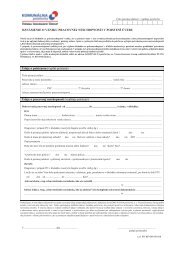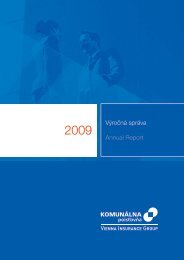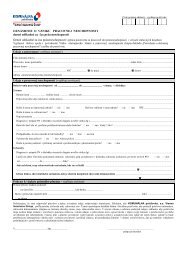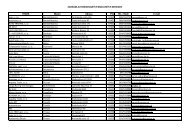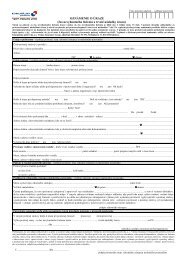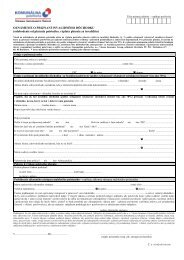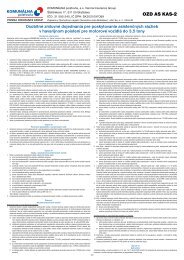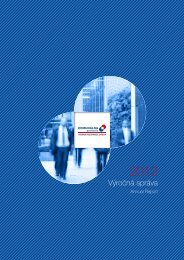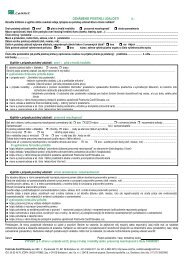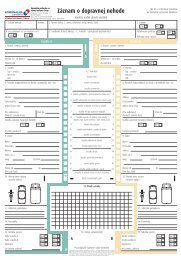kontinuita - Komunálna Poisťovňa
kontinuita - Komunálna Poisťovňa
kontinuita - Komunálna Poisťovňa
Create successful ePaper yourself
Turn your PDF publications into a flip-book with our unique Google optimized e-Paper software.
NOTES TO<br />
THE FINANCIAL<br />
STATEMENTS<br />
c) Deferred acquisition cost (DAC) for insurance contracts<br />
The costs for the acquisition of insurance contracts include<br />
all direct and indirect costs incurred in connection<br />
with concluding insurance contracts. Acquisition<br />
costs incurred in the current accounting period and related<br />
to income of future accounting periods are deferred.<br />
Non-life insurance<br />
Deferred acquisition cost in non-life insurance is calculated<br />
from the total amount of acquisition costs of<br />
the current accounting period, and is divided into current<br />
and future accounting periods in the same proportion<br />
as the technical unearned premium reserve.<br />
Long-term insurance contracts with fixed or guaranteed<br />
contractual terms<br />
Considering the method used for zillmerization of life<br />
insurance reserves, the acquisition costs in life insurance<br />
are deferred by this method and by capitalising<br />
the temporarily negative balances of technical reserves<br />
in life insurance.<br />
Long term insurance contracts without fixed contractual<br />
terms – unit-linked contracts<br />
The Company uses the actuarial funding method for<br />
deferring the acquisition cost. Actuarial funding uses<br />
coefficients in a way that DAC represent the current<br />
amount of calculated unpaid acquisition costs for each<br />
policy at the balance sheet date.<br />
d) Reserve adequacy test<br />
At the balance sheet date, the Company performed a reserve<br />
adequacy test to verify that the amount of reserves<br />
net of the deferred acquisition costs is adequate. To perform<br />
the test, the current best estimate of future contractual<br />
cash flows and the related costs (such as<br />
administrative expenses and claim settlement costs, including<br />
income from investments backing such reserves)<br />
was used. The life insurance contract portfolio<br />
was split into groups (by technical interest rates). For<br />
each group, representative samples were chosen based<br />
on the status of the insurance portfolio and average parameters<br />
for each group (product). In case of insufficiency,<br />
the Company sets up an additional reserve. The<br />
inadequacy of reserves is recognized in the income<br />
statement of the respective accounting period.<br />
e) Reinsurance assets<br />
Contracts with reinsurers under which the Company is<br />
reimbursed for losses on one or more Company’s contracts<br />
that meet the definition of insurance contracts<br />
are classified as reinsurance contracts. Only the rights<br />
arising from contracts where substantial insurance<br />
risk is transferred (insurance contracts) are recognized<br />
as reinsurance assets. The rights arising from<br />
contracts where no substantial insurance risk is transferred<br />
are accounted for as financial assets.<br />
Reinsurance assets contain short-term amounts due<br />
from reinsurers (classified as loans and receivables),<br />
as well as long-term balances due from reinsurers<br />
(classified as reinsurance assets) that depend on the<br />
expected insurance claims and benefits arising under<br />
the related reinsured insurance contracts. Reinsurance<br />
assets are measured at the same basis as the reserves<br />
set up for the respective insurance contracts<br />
reinsured and in accordance with the terms of individual<br />
reinsurance contracts. Reinsurance liabilities are<br />
primarily reinsurance premiums (assigned insurance<br />
premiums) arising from reinsurance contracts that are<br />
recognized as an expense on the same basis as premiums<br />
from the respective insurance contracts.<br />
The Company assesses its reinsurance assets for impairment<br />
at each balance sheet date. If there is an objective<br />
indication that the reinsurance asset is<br />
impaired, the Company reduces the carrying amount<br />
of the reinsurance asset to its recoverable amount and<br />
recognizes that impairment loss in the income statement.<br />
The Company gathers information about objective<br />
indications that a reinsurance asset is impaired<br />
KONTINUITA ANNUAL REPORT 115



